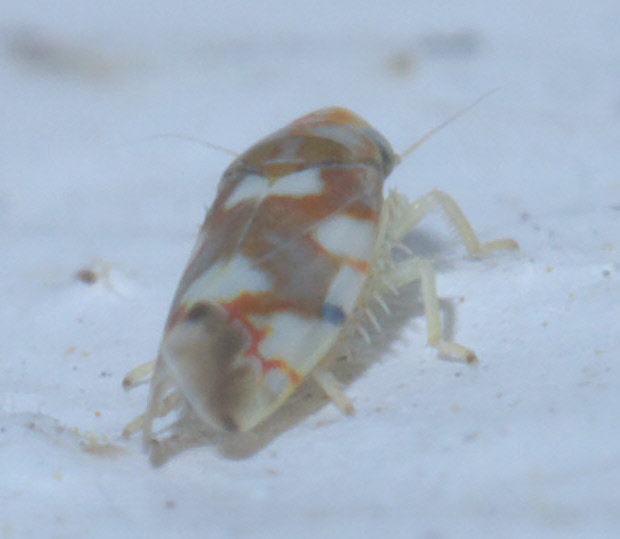|
Erythroneura Elegans
''Erythroneura elegans'' is a species of leafhopper in the family Cicadellidae. The eggs of ''Erythroneura elegans'' may be parasitized by ''Anagrus epos'', a species of fairyfly. References Further reading * * External links * Erythroneurini {{Cicadellidae-stub ... [...More Info...] [...Related Items...] OR: [Wikipedia] [Google] [Baidu] |
Leafhopper
A leafhopper is the common name for any species from the family Cicadellidae. These minute insects, colloquially known as hoppers, are plant feeders that suck plant sap from grass, shrubs, or trees. Their hind legs are modified for jumping, and are covered with hairs that facilitate the spreading of a secretion over their bodies that acts as a water repellent and carrier of pheromones. They undergo a partial metamorphosis, and have various host associations, varying from very generalized to very specific. Some species have a cosmopolitan distribution, or occur throughout the temperate and tropical regions. Some are pests or vectors of plant viruses and phytoplasmas. The family is distributed all over the world, and constitutes the second-largest hemipteran family, with at least 20,000 described species. They belong to a lineage traditionally treated as infraorder Cicadomorpha in the suborder Auchenorrhyncha, but as the latter taxon is probably not monophyletic, many mod ... [...More Info...] [...Related Items...] OR: [Wikipedia] [Google] [Baidu] |
Erythroneura Elegans P1290756a
''Erythroneura'' is a leafhopper genus in the family Cicadellidae. Species (79) ''Erythroneura aclys'' – ''Erythroneura acuticephala'' – ''Erythroneura amanda'' – ''Erythroneura ancora'' – ''Erythroneura anfracta'' – ''Erythroneura ariadne'' – ''Erythroneura atropictila'' – ''Erythroneura aza'' – ''Erythroneura bakeri'' – ''Erythroneura beameri'' – ''Erythroneura bidens'' – ''Erythroneura bistrata'' – ''Erythroneura bistrig'' – ''Erythroneura browni'' – ''Erythroneura caetra'' – ''Erythroneura calycula'' – ''Erythroneura cancellata'' – ''Erythroneura carinata'' – ''Erythroneura cassavae'' – ''Erythroneura chaudhrii'' – ''Erythroneura claripennis'' – ''Erythroneura coloradensis'' – ''Erythroneura comes'' – ''Erythroneura corni'' – ''Erythroneura cymbium'' – ''Erythroneura delicata'' – ''Erythroneura diva'' – ''Erythroneura doris'' – ''Erythroneura elegans'' – ''Erythroneura elegantula'' – ''Erythroneura evansi'' – ''E ... [...More Info...] [...Related Items...] OR: [Wikipedia] [Google] [Baidu] |
Anagrus Epos
''Anagrus epos'' is a species of fairyfly which has been proposed as a biological control agent Biological control or biocontrol is a method of controlling pests, such as insects, mites, weeds, and plant diseases, using other organisms. It relies on predation, parasitism, herbivory, or other natural mechanisms, but typically also invo ... against '' Homalodisca vitripennis''. References Mymaridae Insects described in 1911 {{Chalcidoidea-stub ... [...More Info...] [...Related Items...] OR: [Wikipedia] [Google] [Baidu] |
Fairyfly
The Mymaridae, commonly known as fairyflies or fairy wasps, are a family of chalcidoid wasps found in temperate and tropical regions throughout the world. The family contains around 100 genera with 1400 species. Fairyflies are very tiny insects, like most chalcidoid wasps, mostly ranging from long. They include the world's smallest known insect, with a body length of only , and the smallest known flying insect, only long. They usually have nonmetallic black, brown, or yellow bodies. The antennae of the females are distinctively tipped by club-like segments, while male antennae are thread-like. Their wings are usually slender and possess long bristles, giving them a hairy or feathery appearance, although some species may have greatly reduced stubby wings or lack wings altogether. They can be distinguished from other chalcidoids by the H-shaped pattern of sutures on the front of their heads. Fairyflies are among the most common chalcidoids, but are rarely noticed by humans beca ... [...More Info...] [...Related Items...] OR: [Wikipedia] [Google] [Baidu] |


